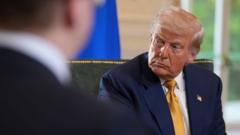The US and EU have announced what is being described as the largest trade deal ever, after talks in Scotland. However, this agreement appears to be more a framework than a finalized deal, with specifics still to be determined. The key announcements from President Donald Trump and EU leader Ursula von der Leyen suggest some sectors might thrive, while others could face tough challenges.
The deal seems like a big win for Trump, who has been promising trade agreements globally. Analysts from Capital Economics predict a GDP dent of 0.5% for the EU, while the US stands to gain significant tax revenues from tariffs on imports. But upcoming economic reports on inflation, jobs, and consumer confidence may indicate whether these trade policies are beneficial in the long run.
Ordinary Americans could feel the pinch as tariffs on EU goods are set to increase prices. For instance, a 15% tariff on a $100 product raises its cost to $115. This added financial burden comes amidst existing inflation worries and rising living costs.
Markets responded positively, with shares in Europe and Asia rising after the announcement of the framework. Investors see the deal as beneficial and are optimistic about the euro's performance.
Yet, the EU faces internal divisions over the agreement. Some member states remain skeptical, voicing concerns over how the deal aligns with their economic interests, particularly in light of ongoing issues like the war in Ukraine.
The car industry is split, with German manufacturers, such as VW and BMW, watching closely as tariffs on imported EU cars drop from 27.5% to 15%. However, this still poses financial challenges for them, and the American auto industry might fear being undercut with the new, lower tariffs on EU vehicles.
Pharmaceutical companies in the EU are also in limbo as the deal's impact on drug tariffs remains unclear, with hopes for exemptions now uncertain. Meanwhile, the US energy sector is expected to thrive, with promises of significant purchases of US liquefied natural gas and other energy resources aimed at replacing Russian imports.
The aircraft industry is also expected to benefit, as tariffs on certain parts and products will remain absent, allowing for smoother trade operations.
In summary, while the trade deal between the US and EU holds promise for some sectors, it raises concerns for others, creating a landscape of both winners and losers.





















